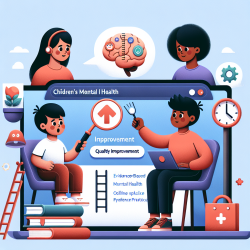Introduction
In the realm of neonatal care, the intersection of ophthalmology and neurology offers a promising frontier for enhancing outcomes in preterm infants. The research article "Optical coherence tomography of the preterm eye: from retinopathy of prematurity to brain development" explores how advancements in optical coherence tomography (OCT) can illuminate pathways for better neurodevelopmental outcomes. This blog post delves into the implications of this research for practitioners, emphasizing data-driven insights and encouraging further exploration.
Understanding the Link Between the Eye and Brain
Retinopathy of prematurity (ROP) is a significant concern for preterm infants, affecting not only their vision but also their overall neurodevelopment. The study highlights that the neurosensory retina, being an extension of the central nervous system, can serve as a window into brain health. Anomalies in the anterior visual pathway often correlate with systemic and CNS health, making OCT a valuable tool in this context.
OCT: A Revolutionary Imaging Modality
OCT provides noninvasive, high-resolution imaging of the infant eye, offering a detailed view of retinal structures. This imaging modality has been adapted for infants, allowing for bedside assessments that can identify potential biomarkers of brain abnormalities. The ability to visualize the microanatomy of the preterm infant eye offers insights into both normal development and potential deviations that could signal neurodevelopmental challenges.
Implications for Practitioners
For practitioners, integrating OCT into routine assessments of preterm infants could revolutionize early detection of neurodevelopmental issues. The study suggests that abnormalities in retinal structures, such as cystoid macular edema (CME) and retinal nerve fiber layer (RNFL) thickness, are linked to poorer neurodevelopmental outcomes. By identifying these markers early, interventions can be tailored to address potential developmental delays.
Encouraging Further Research
The findings of this study open avenues for further research into the relationship between eye microanatomy and brain development. Practitioners are encouraged to explore how OCT can be integrated into telemedicine practices, expanding access to expert evaluations and potentially improving care for preterm infants in remote areas.
Conclusion
Optical coherence tomography offers a powerful tool for practitioners seeking to enhance outcomes for preterm infants. By providing a window into the developing brain through the eye, OCT can facilitate early detection and intervention for neurodevelopmental challenges. As we continue to explore this promising modality, collaboration across disciplines will be key to unlocking its full potential.
To read the original research paper, please follow this link: Optical coherence tomography of the preterm eye: from retinopathy of prematurity to brain development.










